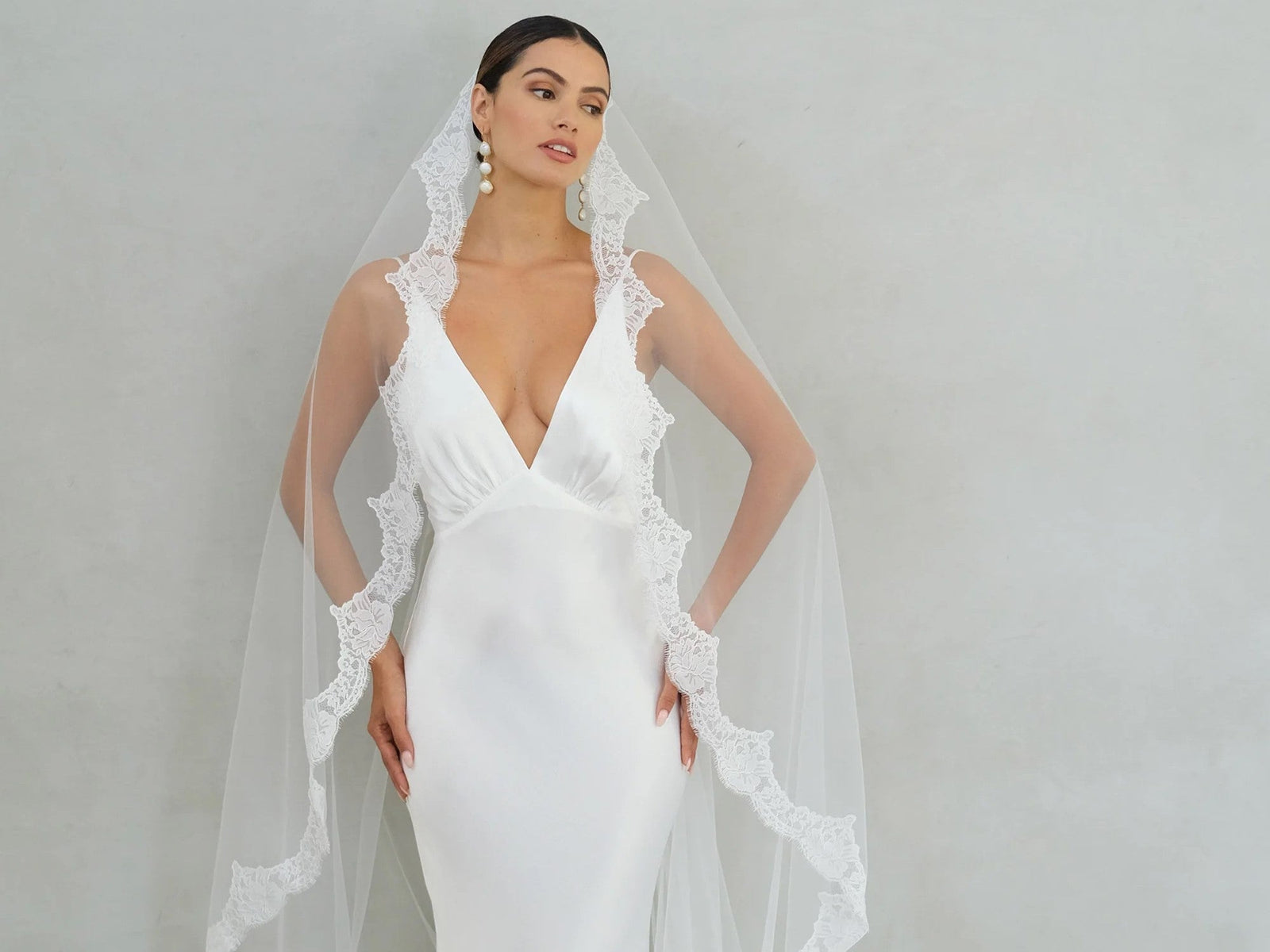Your Cart is Empty
FREE SHIPPING ON ORDERS OVER $250

Mantilla wedding veils have been around for centuries, and this iconic piece isn’t going away soon. Rooted in Latin, Italian, and Spanish cultures, the mantilla has been used by Catholic brides around the world to personalise and enhance their wedding ensemble.
Whether seeking a traditional or modern look, a mantilla wedding veil can be customised to reflect a bride’s unique taste. This symbolic wedding accessory, which comes in various lengths, styles, and materials, makes every bride a sight to behold on her big day.
Whether seeking a traditional or modern look, a mantilla wedding veil can be customised to reflect a bride’s unique taste. This symbolic wedding accessory, which comes in various lengths, styles, and materials, makes every bride a sight to behold on her big day.
What is a mantilla veil?
Mantilla wedding veils are designed to frame a bride’s face and cover her hair, shoulders, and back, depending on the length. These bridal pieces can be short and draped across the bride’s shoulder, long enough to touch the floor, or feature a long train, like cathedral veils. They may be worn alone or with an additional layer called a blusher veil to cover the bride’s face.
The timeless tradition of wearing mantilla veils
Derived from the Spanish word ‘manta,’ which means ‘blanket,’ a mantilla veil often refers to a lace cloth worn over a woman’s head. In the past, women were required to wear them to mass as a symbol of modesty and humility. Soon after, these symbolisms were adopted in other church activities, including weddings.
While the Church no longer requires women to wear veils for attending masses, the timeless tradition of wearing a mantilla wedding veil remains, mainly due to their significance.
What’s the best material for a mantilla veil?
A lace mantilla veil and a lightweight tulle fabric are the best wedding veil material choices. These exquisite bridal pieces are adorned with various designs on their edges, whether scalloped trims, floral appliques, or intricate beadwork, among other decorative elements. A lightweight fabric that’s easy to work on, like tulle and lace, enables a bride to choose from various customisation options.
How to wear a mantilla veil
A mantilla is kept in place with a decorative comb called a peineta, placed underneath the veil either on the head or in a cascade. Placing the peineta two inches above your hairline helps embellish your face within the veil’s lace borders.
You can place a few bobby pins the same colour as your hair to secure them better. Other ways to secure a mantilla include tying the veil like a Juliet cap, forming knots at the back of your head.
The best hairstyles for a mantilla wedding veil
A mantilla can be worn over just about any hairstyle except for a high bun, as the added height may affect the veil’s aesthetic impact in framing your face. Settle for a low bun to preserve the veil’s orientation and achieve the ideal look.
Whatever mantilla veil design and hairstyle you choose, don’t forget to test it before walking down the aisle. Move your head around a little while wearing it. The last thing you want is for your mantilla to fall off mid-ceremony, especially if you prefer to wear your hair down.

What’s the ideal mantilla bridal veil length?
Consider the following lengths for your mantilla veil, depending on your desired look.
A wedding veil is more than a traditional bridal head cover. It can completely transform your entire bridal look and should represent your style. Short and mid-length wedding veils often appeal to classy and modern brides. In contrast, longer veils attract brides with a more traditional and classic fashion sense.
How to pair a mantilla veil with your wedding dress
As with any other wedding accessory, mantilla veils should be paired with the ideal wedding dress. We’ve outlined some tips for pairing dresses and veils in one of our blogs.
To summarise, below are the most essential considerations:
However, there are no hard and fast rules in fashion. While deeply rooted in tradition, modern times have allowed women to choose a mantilla veil design that suits their taste. Hence, what’s ideal for one bride isn’t automatically the best option for another.
That said, it’s best to allow yourself enough time to think about the dress and mantilla veil to go with it – ideally 12 to 18 months before the big day. It may seem like a long time, but you don’t want to regret your decision when it’s too late. 
Where to buy a mantilla veil
Off-the-rack and personalised mantilla veils are available at wedding shops and bridal accessories designers. Work with the latter to help you get the best value for your budget while prioritising your preference and achieving a cohesive look.
Conclusion
In a wedding ceremony, the mantilla wedding veil stands out as much as the dress that it’s paired with. It’s best to choose a mantilla veil that creates a seamless look with your wedding dress and theme. Taking heed of the points in this guide will help you choose a veil that provides a timeless appeal that brides can’t afford to turn down.